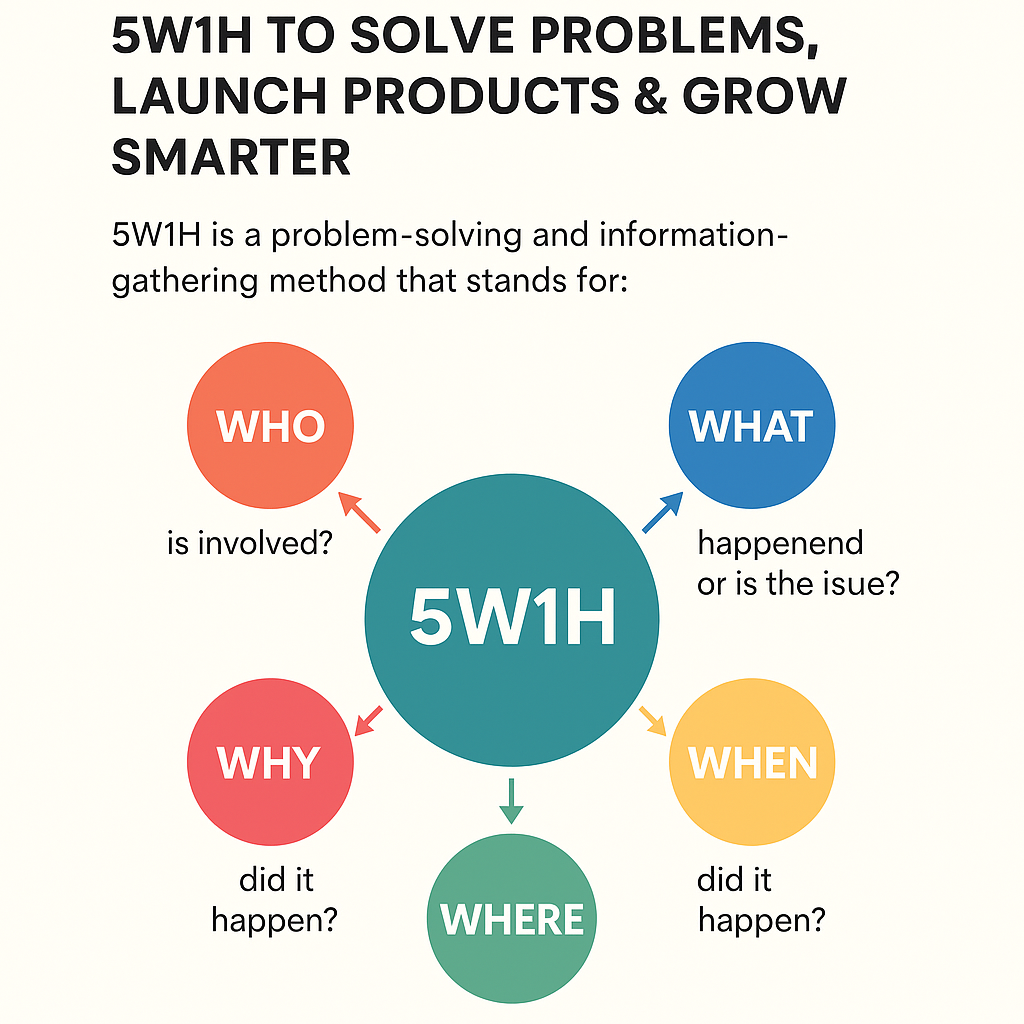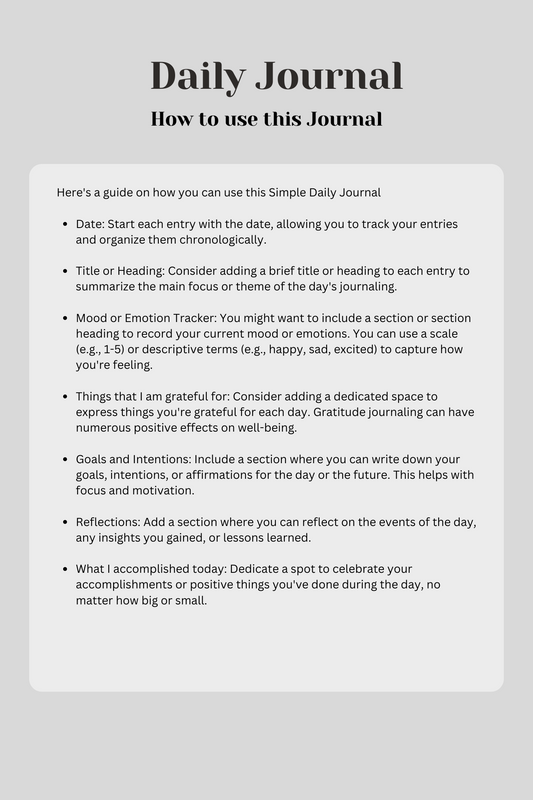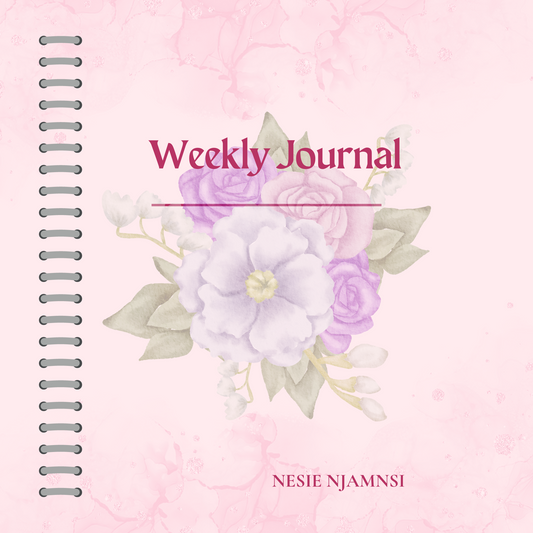5W1H is a problem-solving and information-gathering method that stands for:
- Who – is involved?
- What – happened or is the issue?
- When – did it happen?
- Where – did it happen?
- Why– did it happen?
- How – did it happen?

Purpose:
It’s used to gain a full understanding of a situation, problem, or plan. This method is commonly used in:
- Journalism
- Business analysis
- Project planning
- Root cause analysis
- Marketing strategy
- Incident investigation
Example (Product Launch):
- Who is the target audience?
- What is the product?
- When will it launch?
- Where will it be sold?
- Why is it being launched now?
- How will it be marketed?
How Business Owners Can Use 5W1H
1. WHO
- Define target customers (Who are we serving?)
- Identify team members or stakeholders involved
- Understand who is responsible for each task or goal
Example: Who is buying our handmade vintage bags?
2. WHAT
- Clarify what your product or service offers
- Define what the problem or opportunity is
- Understand what competitors are doing
Example: What makes our toy collectibles different from others on Etsy?
3. WHEN
- Set deadlines, launch dates, and project timelines
- Understand when customers make purchases
- Track seasonal trends or demand shifts
Example: When do most of our toy sales happen—holidays, weekends, or birthdays?
4. WHERE
- Decide where to sell or market (online, in-store, social platforms)
- Identify where your audience spends time
- Choose the best location for business operations
Example: Where should we promote our business—TikTok, eBay, or toy fairs?
5. WHY
- Clarify the purpose behind a decision or action
- Understand why a product is needed or why something went wrong
- Define your unique value proposition (UVP)
Example: Why are customers abandoning carts before completing the purchase?
6. HOW
- Map out how to implement plans
- Document how a product is made, marketed, or delivered
- Analyze how to improve efficiency or reduce costs
Example: How can we reduce shipping costs for pre-owned toys?
As a business owner juggling multiple responsibilities—from product development and team management to customer service and marketing—it’s easy to get lost in the chaos. That’s where 5W1H comes in as your secret weapon.
5W1H stands for:
- Who
- What
- When
- Where
- Why
- How
This method is simple but powerful, helping you break down situations, clarify actions, and improve decision-making. Whether you're launching a new product or creating standard procedures, 5W1H brings structure and clarity.
Let’s explore how business owners can apply 5W1H to five key business functions:
1. Launching New Products with 5W1H
5W1H Table: Launching New Products
| Category | Guiding Questions | Your Answers / Notes |
| Who | - Who is the target customer?- Who is responsible for product creation, marketing, and launch?- Who will support the launch (team, partners, influencers)? | |
| What | - What is the product?- What problem does it solve or need does it meet?- What are its features and benefits? | |
| When | - When is the ideal launch date?- When will marketing and pre-launch activities begin?- When should inventory or systems be ready? | |
| Where | - Where will the product be sold (website, marketplace, physical store)?- Where will the launch be promoted (social media, email, events)? | |
| Why | - Why is this product being launched now?- Why will it matter to customers?- Why is it different from competitors? | |
| How | - How will the product be developed, tested, and finalized?- How will it be promoted and launched?- How will success be measured (KPIs)? |
Bringing a new product to market requires thoughtful planning. The 5W1H method helps ensure that your launch is not only successful but strategic.
Who
- Who is your target customer?
- Who will be involved in the product launch (team members, influencers, partners)?
Example: Who will buy this product? Millennials, busy moms, collectors?
What
- What is the product?
- What problem does it solve or benefit does it offer?
Example: What makes this skincare lotion different from others?
When
- When will you launch it?
- When should pre-marketing begin?
Example: Launch in early November to catch holiday shoppers.
Where
- Where will you sell it? (e.g., Shopify, Etsy, Amazon)
- Where will the launch campaign run? (Instagram, email, blogs)
Example: Sell online via your website and promote through email and Instagram ads.
Why
- Why are you launching this now?
- Why should customers care?
Example: Customers want more natural skincare options—and this fills that gap.
How
- How will you design, price, promote, and distribute the product?
Example: Create a presale campaign with 20% off + testimonials from beta testers.
2. Solving Team Conflicts with 5W1H
5W1H Table: Solving Team Conflicts
| Category | Guiding Questions | Your Answers / Notes |
| Who | - Who is involved in the conflict?- Who is being affected directly or indirectly?- Who can help mediate or resolve the situation? | |
| What | - What caused the conflict?- What actions, behaviors, or miscommunications contributed to it?- What has already been done to address it? | |
| When | - When did the issue first arise?- When did it escalate?- When should resolution steps be taken? | |
| Where | - Where did the conflict occur (in person, email, Zoom, team chat)?- Where is it having the most impact (team dynamics, productivity, morale)? | |
| Why | - Why did the conflict happen?- Why has it not been resolved yet?- Why is resolution important right now? | |
| How | - How can this conflict be resolved respectfully?- How will communication be improved moving forward?- How can future conflicts be prevented? |
Internal conflict can stall progress and damage morale. Use 5W1H to approach issues constructively.
Who
- Who is involved in the conflict?
- Who is affected by it?
Example: Is it between two team members or across departments?
What
- What happened that led to the conflict?
- What are the perspectives of each side?
Example: Miscommunication about deadlines or unclear roles.
When
- When did the conflict start?
- When was the last time it escalated or affected work?
Example: Did the issue build up over time, or was it triggered recently?
Where
- Where did the misunderstanding happen? (During a meeting, in Slack, over email?)
Example: Clarify if it was due to tone in written communication.
Why
- Why did this conflict arise?
- Why is it continuing?
Example: Maybe unclear expectations or lack of accountability caused the issue.
How
- How can you resolve it fairly?
- How will communication be improved going forward?
Example: Host a mediation meeting, revise processes, or provide team training.
3. Improving Customer Service with 5W1H
5W1H Table: Improving Customer Service
| Category | Guiding Questions | Your Answers / Notes |
| Who | - Who are our customers facing service issues?- Who handles customer support (team or individual)?- Who are our best-performing support staff? | |
| What | - What are the most common customer complaints?- What aspects of service need improvement (speed, tone, resolution)?- What tools or resources are currently used? | |
| When | - When do most customer issues occur (after purchase, during checkout, etc.)?- When are response times slow or delayed?- When was the last support training session? | |
| Where | - Where are customers reaching out from (email, chat, social media)?- Where are the breakdowns in the support process?- Where can we add more support coverage? | |
| Why | - Why are customers dissatisfied?- Why are certain issues recurring?- Why are current systems not resolving issues fast enough? | |
| How | - How can we improve support training or response systems?- How will we monitor satisfaction (surveys, reviews)?- How can we make our help center or FAQs more effective? |
Customer service makes or breaks your reputation. Use 5W1H to identify gaps and make impactful improvements.
Who
- Who are your customers experiencing issues?
- Who is handling customer support?
Example: Is it repeat buyers having issues or first-time users?
What
- What are the most common complaints?
- What kind of service do your competitors offer?
Example: Are delays, poor packaging, or lack of response causing dissatisfaction?
When
- When do most support requests come in?
- When was your last review of service quality?
Example: More requests might come after product launches or sales events.
Where
- Where are customers reaching out (email, social media, website)?
- Where are they dropping off or leaving negative feedback?
Example: Monitor where your response times are slowest.
Why
- Why are customers frustrated?
- Why is your support not meeting expectations?
Example: Maybe the team is understaffed, or FAQs aren’t accessible.
How
- How can you improve?
- How will you measure success?
Example: Add a live chat, train staff, set response time goals, and send satisfaction surveys.
4. Running Strategic Marketing Campaigns with 5W1H
5W1H Table: Running Strategic Marketing Campaigns
| Category | Guiding Questions | Your Answers / Notes |
| Who | - Who is the target audience?- Who is responsible for campaign strategy, creation, and execution?- Who are the collaborators (influencers, partners, designers)? | |
| What | - What is the goal of the campaign (sales, leads, awareness)?- What message, offer, or product are we promoting?- What platforms or formats will we use (video, blog, email, etc.)? | |
| When | - When will the campaign run (start/end dates)?- When should each content piece go live?- When will you evaluate performance (weekly, end of campaign)? | |
| Where | - Where will the campaign be visible (Instagram, Facebook, YouTube, website)?- Where is the audience most active?- Where are they most likely to convert? | |
| Why | - Why is this campaign important to our business right now?- Why will it resonate with our audience?- Why is this the right channel/approach? | |
| How | - How will the campaign be executed (workflow, tools, roles)?- How will results be measured (KPIs like CTR, conversions, ROAS)?- How will we follow up after the campaign ends? |
Marketing without strategy is like shooting in the dark. 5W1H keeps your campaigns focused and effective.
Who
- Who are you targeting?
- Who is managing the campaign?
Example: Is your campaign tailored to moms, teens, or collectors?
What
- What is the message or offer?
- What platforms will be used?
Example: Launch a “Buy One, Gift One” campaign on Instagram and email.
When
- When will the campaign run?
- When should testing and pre-launch content begin?
Example: Schedule for back-to-school or holiday season.
Where
- Where will your audience see it? (Instagram, TikTok, Pinterest, YouTube, Google)
Example: Focus on TikTok if your product is trending with Gen Z.
Why
- Why will this campaign work?
- Why does your audience need this now?
Example: Limited-time offer encourages urgency. Solves a relevant problem.
How
- How will the campaign be created, promoted, and tracked?
Example: Use Canva for creatives, run Facebook ads, track through Google Analytics.
5. Creating Standard Operating Procedures (SOPs) with 5W1H
5W1H Table: Creating Standard Operating Procedures (SOPs)
| Category | Guiding Questions | Your Answers / Notes |
| Who | - Who is responsible for carrying out this procedure?- Who needs to follow it?- Who reviews and approves the SOP? | |
| What | - What task, process, or routine does this SOP cover?- What tools, software, or materials are needed?- What are the expected outcomes? | |
| When | - When should this process be performed (daily, weekly, when triggered)?- When was this SOP last updated or reviewed?- When do exceptions apply (if any)? | |
| Where | - Where does this process take place (department, platform, location)?- Where should the SOP be accessed/stored? | |
| Why | - Why is this procedure important?- Why must it be done this way (compliance, efficiency, safety)?- Why was this SOP created or revised? | |
| How | - How is the process performed step-by-step?- How should results be documented or tracked?- How can improvements be suggested or errors reported? |
SOPs improve consistency, onboarding, and efficiency. 5W1H ensures they’re clear and comprehensive.
Who
- Who is responsible for each task or step?
- Who needs to follow this SOP?
Example: Identify who completes order fulfillment or customer onboarding.
What
- What task or process does the SOP cover?
- What tools or platforms are needed?
Example: SOP for responding to customer emails or updating product listings.
When
- When should each step be completed?
- When was the SOP last reviewed or updated?
Example: Email responses must be sent within 24 hours of receipt.
Where
- Where is the SOP stored or accessed?
- Where does each step take place (physically or digitally)?
Example: Stored in Notion or Google Drive; steps performed in Shopify.
Why
- Why is this SOP important?
- Why does it need to be followed exactly?
Example: Ensures quality and avoids mistakes that lead to customer complaints.
How
- How is each step done correctly?
- How can this be improved or automated in the future?
Example: Include screenshots, videos, or checklists for clarity.
Final Thoughts: Why 5W1H is a Business Owner's Best Friend
The 5W1H method isn’t just for reporters or detectives—it’s a smart and strategic tool for business owners who want to think clearly, act intentionally, and grow sustainably. It empowers you to make confident decisions and ensures you ask the right questions before taking action.
Use 5W1H as a recurring framework when:
- You’re facing uncertainty or confusion
- You want to document or train team members
- You’re building systems to scale your business
-
You want to optimize existing processes





